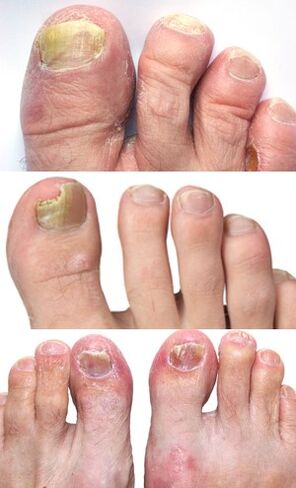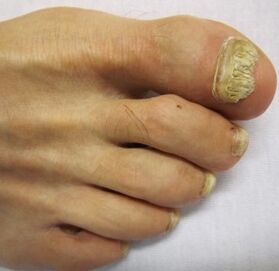The fungus damages both parts and the entire nail, including the nail plate, bed and nail roots. The infection develops slowly, causing the nails to discolor, thicken, and bend. The corresponding symptoms may be skin lesions on the fingers, peeling, itching and redness. Over time, nails become deformed so that it interferes with, for example, wearing ordinary shoes.
Often, the fungus affects the toenails. The medical name is onychomycosis. It is widely found in the elderly and rarely in children. In most cases, nail mycosis develops under the influence of dermatophyte fungi, which also affect the skin. Sometimes the disease is caused by another type of fungus.
In mild cases, nail treatment may not be necessary. To determine the true cause of the infection and rule out the possibility of other diseases, a dermatologist will analyze the cut nail. Nail fungus can be cured, but sometimes it takes months. Antifungal medications come in the form of pills and nail polish. If nail fungus develops, they require surgery to remove the nail. There are also laser treatment methods.
Signs and symptoms of nail fungus
The most common symptoms of onychomycosis are discoloration and deformation of the nails. Nails can turn white, black, yellow, or green. As a rule, nail fungus is not too alarming at first and in most cases does not cause complications. If the infection is not treated, pain in the affected nail may arise. Nail fungus is difficult to walk and wear on shoes, and if your fingernails are affected, it is difficult to write.
As onychomycosis develops, other symptoms appear, for example, the nail may become brittle, loose, or completely flaky from the base of the nail. If left untreated, fungal infections can spread to the skin of the fingers and interdigital space. White or yellow spots may appear on the nail bed, and the skin around the nail may peel off. All these changes can be seen in the photos of nail fungus.
Causes of nail fungus

The most common cause of nail damage is a fungal skin infection, such as foot fungus. Usually, foot fungus develops on the skin between the toes, causing it to become red, flaky and itchy. Fungi grow and multiply quickly in warm, humid environments, so prolonged wearing of shoes or sweating increases the chances of getting an infection. In about one-third of people with foot fungus, nail damage occurs.
Nail fungus can be caused by an infection caused by candida yeast, which is also a cause of diseases such as thrush or stomatitis. The chances of getting nail fungus are higher if at work a person has to wash their hands often or keep their hands in water for long periods of time. Moisture peels off the skin at the base of the nail, making it easier for fungus to enter the nail. The risk of candidal nail lesions is higher with certain diseases, namely:
- diabetes mellitus or psoriasis;
- weakened immunity, for example, to HIV;
- poor general health.
Other factors that can increase the risk of getting nail fungus include:
- wearing fake nails;
- damage to nails;
- persistent nail bites;
- living in hot and humid climates;
- smoking.
With age, the chances of getting nail fungus increase. Sometimes fungi appear for no apparent reason.
Nail fungus treatment
In mild cases, treatment may not be necessary. However, if left untreated, the infection can spread to other nails and the skin of your toes and hands. To get rid of nail mycosis as quickly as possible, it is important to follow simple rules: give up shoes with sweaty feet, trim nails and monitor foot hygiene carefully.
With the use of medications, healthy new nails will begin to grow at the base of the nail base, which indicates that the treatment is very helpful. Old-affected nails will grow back gradually and can be cut in a few months. If, after 2-3 weeks of treatment, new nails do not begin to grow, you should see a doctor. It is not possible to stop using the prescribed medication without seeing a doctor, as this can lead to a return of the infection.
Foot care tips for toenail fungus
Below are tips on how to deal with infections during and after treatment.
- keep the feet dry and cool, socks and shoes should allow the feet to "breathe";
- wear clean cotton socks and try to wear as few sneakers as possible;
- start treatment for foot fungus at the first signs of damage to prevent the infection from spreading to the nails;
- cut nails properly;
- remove the affected part of the nail with separate scissors to prevent the spread of infection;
- wear shoes of appropriate size with low heels and with wide toes;
- wearing clean slippers in public baths;
- if walking is difficult due to thickened nails, see a dermatologist;
- it is advisable to get rid of old shoes that may be contaminated with fungal spores.
Remedy for nail fungus

When antifungal tablets are taken, the medicine reaches the nail through the bloodstream. Often, terbinafine and itraconazole are prescribed for nail fungus, which is a very effective remedy. However, it takes several months of therapy to get rid of the infection completely. If treatment is not completed, the infection may return.
The advantage of the pills is that they will simultaneously help get rid of related fungal infections, such as foot fungus. Possible side effects of antifungal pills:
- Headache;
- itching;
- loss of taste;
- nausea;
- diarrhea.
Topical remedy for nail fungus
Antifungal nail polish can be used as a substitute for pills. It is not as effective as the pill because the drug is applied to the affected nail and needs to reach the site of infection through it. It is often not possible to cover the entire lesion. Nail treatment on the hands can take about six months, on toenails - up to a year.
To remove the affected nail plate, you can use a paste containing 40% urea. This pasta is sold over the counter without a prescription. At night, the paste is gently rubbed on the affected nail, which is then covered with an overnight bandage. In the morning, the paste is washed, and in the evening the nails are inserted according to the instructions and the procedure is repeated. In about two weeks, the fungus-affected nails dissolve.
This is a painless procedure that allows you to remove the affected nail plate and get rid of the fungus. It avoids taking medication for several months and painful surgery. Once the nail plate dissolves, antifungal varnish should be applied to the nails twice a week so that new nails are not infected.
Surgery and laser treatment for onychomycosis
If nail fungus is advanced or severely ill, nail removal surgery may be recommended if other treatments fail. After surgery, over time, new ones will grow at the site of the removed nail, but this may take a year or longer.
Another method of treating advanced nail fungus is laser treatment. The laser emits powerful light energy that kills the fungus. Research results show that this method of treatment is safe and effective, with some studies achieving 90% effectiveness after 3 months. However, there is little data on the long -term effectiveness of this method, as most studies follow people for only 3 months. To achieve lasting results, you need to undergo treatment every 3 months for a maximum of one year. This procedure can be expensive.
The need for treatment and choice of medication should be consulted with a dermatologist. Once the infection is cleared, the nail will not return to its original appearance. In these cases, pieces of the nail are taken for analysis to determine if the infection remains on the thickness of the nail despite treatment.

























